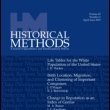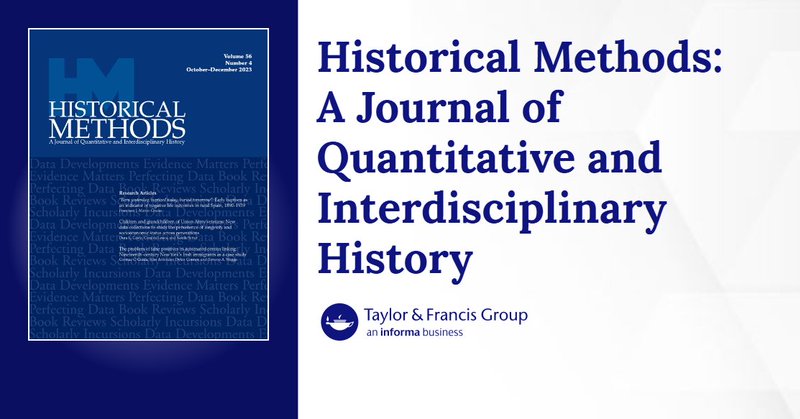
HistoricalMethods
@HistMethod
Followers
193
Following
2
Media
10
Statuses
33
Academic journal focused on interdisciplinary explorations of new data sources and new methodological approaches. For international audiences
Joined February 2021
Issue 2, 2022 of @HistMethod presents "Inferring “missing girls” from child sex ratios in historical census data" by @aj_szo , Bartosz Ogórek, Siegfried Gruber & Francisco J. Beltrán Tapia
1
1
7
This article is available here (it's open access!):.
tandfonline.com
A lack of regional data on the occupational structure in England and Wales during the interwar years has so far prevented extensive study of this time period. In the current paper, we fill this gap...
0
0
0
Issue 2, 2022 of @HistMethod presents "The regional occupational structure in interwar England and Wales" by Robin C. M. Philips, Matteo Calabrese, Robert Keenan & Bas van Leeuwen
1
3
0
Issue 2, 2022 of @HistMethod presents "British employer census returns in new digital records 1851–81; consistency, non-response, and truncation – what this means for analysis" by Robert J. Bennett & Leslie Hannah
1
3
7
Issue 1, 2022 of @HistMethod presents "EconHist: a relational database for analyzing the evolution of economic history (1980–2019)" by @AlvaroLaParra, Félix-Fernando Muñoz & Nadia Fernandez-de-Pinedo @Nadsfp
1
10
13
Issue 1, 2022, also includes "Overflowing tables: Changes in the energy intake and the social context of Thanksgiving in the United States" by Diana Thomas @MathArmy, G.Yoshitani, D.Turner, A.Hariharan, S.Bhutani, D.B.Allison, A.Moniz,S.Heymsfield, D.A.Schoeller,H.Hull & D.Fields
1
1
0
The co-authors on this publication were: @joepricebyu , Jacob Wellington, Kelly J Thompson, @HistDem & @CathyFitch.
0
0
0
Using 1900-1920 census data from DC, Georgia, Michigan and New York, the authors argue "Black naming patterns existed in the antebellum era and. racial distinctiveness in naming patterns was an established practice well before Emancipation." @drlisadcook @jmparman @TrevonDLogan.
0
0
2
Another article included in @HistMethod Issue 1, 2022, is "The antebellum roots of distinctively black names" by Lisa D. Cook, John Parman & Trevon Logan
tandfonline.com
This paper explores the existence of distinctively Black names in the antebellum era. Building on recent research that documents the existence of a national naming pattern for African American male...
1
0
9
Check out this presentation by Jonas Helgertz, who also published a recent article in @HistMethod titled "A new strategy for linking U.S. historical censuses: A case study for the IPUMS multigenerational longitudinal panel" (available here .
tandfonline.com
This paper presents a probabilistic method of record linkage, developed using the U.S. full count censuses of 1900 and 1910 but applicable to many sources of digitized historical records. The metho...
Interested in the newest developments of record linkage techniques for historical censuses? Join our next seminar with Jonas Helgertz (@minnpop @ipums). 📅 Thursday, 9th June, 11:30 AM.📧genpop@unibo.it to get info and the link
1
1
3









